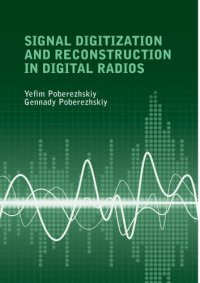
Ebook: Signal digitization and reconstruction in digital radios
- Tags: Radio--Receivers and reception, Signal processing--Digital techniques, Signal processing -- Digital techniques, Radio -- Receivers and reception
- Series: Artech House signal processing library
- Year: 2019
- Publisher: Artech House
- City: Norwood, MA
- Language: English
- pdf
Ch. 1 Signals and Waveforms -- 1.1.Overview -- 1.2.Signals and Their Processing -- 1.2.1.Analog, Discrete-Time, and Digital Signals -- 1.2.2.Deterministic and Stochastic Signals -- 1.2.3.Basic Operations on Signals -- 1.3.Expansions of Signals -- 1.3.1.Orthogonal Expansions -- 1.3.2.Trigonometric and Exponential Fourier Series -- 1.3.3.Fourier Transform and Its Properties -- 1.3.4.Spectral Distribution of Signal Energy and Power -- 1.3.5.Transmission of Signals Through LTI Systems -- 1.4.Baseband and Bandpass Signals -- 1.4.1.Baseband Signals and Modulation -- 1.4.2.Bandpass Signals and Their Complex-Valued Equivalents -- 1.4.3.Bandwidths of Signals and Circuits -- 1.5.Summary -- References -- ch. 2 Radio Systems -- 2.1.Overview -- 2.2.Radio Systems and Radio Spectrum -- 2.2.1.Diversity of Radio Systems -- 2.2.2.RF Spectrum and Its Utilization -- 2.3.Radio Communication Systems -- 2.3.1.General -- 2.3.2.Communication Txs and Rxs -- 2.3.3.Channel Coding, Modulation, and Spreading -- 2.4.Other Radio Systems -- 2.4.1.Broadcasting Systems -- 2.4.2.Radio Navigation and Positioning Systems -- 2.4.3.Radio Methods in Positioning and Geolocation -- 2.4.4.Radar and EW Systems -- 2.5.Summary -- References -- ch. 3 Digital Transmitters -- 3.1.Overview -- 3.2.Digital Tx Basics -- 3.2.1.Txs of Different Categories of Digital Radios -- 3.2.2.Architecture of a Digital Tx -- 3.2.3.Direct Digital Synthesis -- 3.3.D&R in a Digital Tx -- 3.3.1.Digitization of TDP Input Signals -- 3.3.2.Reconstruction of TDP Output Signals -- 3.3.3.Comparison of Reconstruction Techniques and Conversion Block Architectures -- 3.4.Power Utilization Improvement in Txs -- 3.4.1.Power Utilization in Txs with Energy-Efficient Modulation -- 3.4.2.AQ-DBPSK Modulation -- 3.4.3.Power Utilization in Txs with Bandwidth-Efficient Modulation -- 3.5.Summary -- References -- ch. 4 Digital Receivers -- 4.1.Overview -- 4.2.Digital Rx Basics -- 4.2.1.First Steps of Digital Radio Development -- 4.2.2.Main Characteristics of Rxs -- 4.2.3.Digital Rxs and Txs -- 4.3.Dynamic Range of a Digital Rx -- 4.3.1.Factors Limiting Rx Dynamic Range -- 4.3.2.Intermodulation -- 4.3.3.Required Dynamic Range of an HF Rx -- 4.4.Digitization in a Digital Rx -- 4.4.1.Baseband Digitization -- 4.4.2.Bandpass Digitization -- 4.4.3.Comparison of Digitization Techniques and Architectures of AMFs -- 4.5.Demodulation of Energy-Efficient Signals -- 4.5.1.Demodulation of Differential Quadrature Phase-Shift Keying Signals with DS Spreading -- 4.5.2.Demodulation of AQ-DBPSK Signals -- 4.6.Summary -- References -- ch. 5 Sampling Theory Fundamentals -- 5.1.Overview -- 5.2.S&I from a Historical Perspective -- 5.2.1.Need for S&I at the Dawn of Electrical Communications -- 5.2.2.Discovery of Classical Sampling Theorem -- 5.2.3.Sampling Theory After Shannon -- 5.3.Uniform Sampling Theorem for Baseband Signals -- 5.3.1.Sampling Theorem and Its Constructive Nature -- 5.3.2.Interpretations of Sampling Theorem -- 5.3.3.Baseband S&I Corresponding to Indirect Interpretation -- 5.4.Uniform Sampling Theorem for Bandpass Signals -- 5.4.1.Baseband S&I of Bandpass Signals -- 5.4.2.Bandpass S&I of Bandpass Signals -- 5.4.3.Comparison of Baseband and Bandpass S&I of Bandpass Signals -- 5.5.Summary -- References -- ch. 6 Realization of S&I in Digital Radios -- 6.1.Overview -- 6.2.S&I Based on the Sampling Theorem's Indirect Interpretation -- 6.2.1.Sampling Based on the Indirect Interpretation -- 6.2.2.Interpolation Based on the Indirect Interpretation -- 6.3.S&I Based on the Sampling Theorem's Hybrid Interpretation -- 6.3.1.Sampling Based on the Hybrid Interpretation -- 6.3.2.Interpolation Based on the Hybrid Interpretation -- 6.4.S&I Based on the Sampling Theorem's Direct Interpretation -- 6.4.1.Sampling Based on the Direct Interpretation -- 6.4.2.Interpolation Based on the Direct Interpretation -- 6.5.Channel Mismatch Mitigation -- 6.5.1.Approaches to the Problem -- 6.5.2.Separation of Signal and Error Spectra -- 6.5.3.Channel Mismatch Compensation -- 6.6.Selection and Implementation of Weight Functions -- 6.6.1.Theoretical Basis -- 6.6.2.B-Spline-Based Weight Functions -- 6.6.3.Additional Remarks on Weight Function Implementation -- 6.7.Need for Hybrid and Direct Interpretations -- 6.7.1.Evaluation of Hybrid and Direct Interpretations' Advantages -- 6.7.2.Two-Stage Spatial Suppression of ISs -- 6.7.3.Virtual-Antenna-Motion-Based Spatial Suppression of ISs -- 6.8.Summary -- References -- ch. 7 Improving Resolution of Quantization -- 7.1.Overview -- 7.2.Conventional Quantization -- 7.2.1.Quantization of Rx Input Signals -- 7.2.2.Quantization of Tx Input Signals -- 7.3.Joint Quantization of Samples -- 7.3.1.Principles of Joint Quantization -- 7.3.2.Design Considerations -- 7.4.Compressive Quantization of Images -- 7.4.1.Basic Principles -- 7.4.2.Design Considerations -- 7.4.3.Assessment of Benefits -- 7.5.Summary -- References -- APPENDIX A Functions Used in the Book -- A.1.Rectangular and Related Functions -- A.2.Delta Function -- A.3.B-Splines -- APPENDIX B Sampling Rate Conversion in Digital Radios -- B.1.Downsampling by an Integer Factor -- B.2.Upsampling by an Integer Factor -- B.3.Sampling Rate Conversion by a Noninteger Factor -- B.4.Optimization of Sampling Rate Conversion -- B.5.Generalization -- APPENDIX C On the Use of Central Limit Theorem -- C.1.Paradox Statement -- C.2.Paradox Resolution -- C.3.Discussion -- APPENDIX D Sampling Theorem for Bandlimited Signals -- D.1.Sampling Theorem for Baseband Signals -- D.1.1.Theorem -- D.1.2.Proof -- D.1.3.Discussion -- D.2.Sampling Theorem for Bandpass Signals -- D.2.1.Sampling of Bandpass Signals Represented by I(t) and Q(t) -- D.2.2.Sampling of Bandpass Signals Represented by U(t) and 6(t) -- D.2.3.Sampling of Bandpass Signals' Instantaneous Values.
Download the book Signal digitization and reconstruction in digital radios for free or read online
Continue reading on any device:

Last viewed books
Related books
{related-news}
Comments (0)